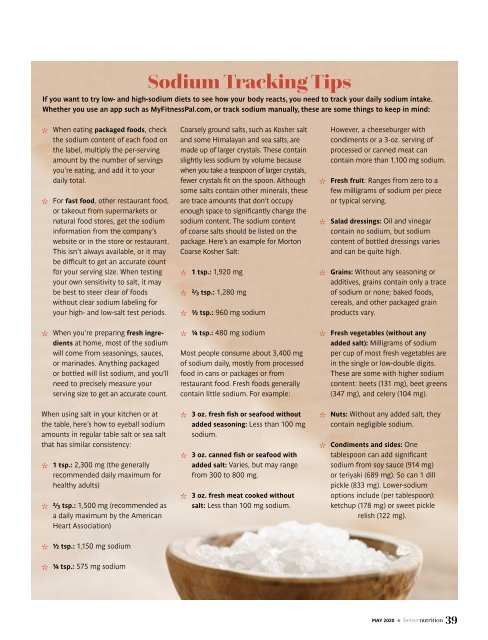You also want an ePaper? Increase the reach of your titles
YUMPU automatically turns print PDFs into web optimized ePapers that Google loves.
Sodium Tracking Tips<br />
If you want to try low- and high-sodium diets to see how your body reacts, you need to track your daily sodium intake.<br />
Whether you use an app such as MyFitnessPal.com, or track sodium manually, these are some things to keep in mind:<br />
*<br />
When eating packaged foods, check Coarsely ground salts, such as Kosher salt<br />
the sodium content of each food on and some Himalayan and sea salts, are<br />
the label, multiply the per-serving made up of larger crystals. These contain<br />
amount by the number of servings slightly less sodium by volume because<br />
you’re eating, and add it to your when you take a teaspoon of larger crystals,<br />
daily total.<br />
fewer crystals fit on the spoon. Although<br />
some salts contain other minerals, these<br />
For fast food, other restaurant food, are trace amounts that don’t occupy<br />
*<br />
or takeout from supermarkets or enough space to significantly change the<br />
natural food stores, get the sodium sodium content. The sodium content<br />
information from the company’s of coarse salts should be listed on the<br />
website or in the store or restaurant. package. Here’s an example for Morton<br />
This isn’t always available, or it may Coarse Kosher Salt:<br />
be difficult to get an accurate count<br />
for your serving size. When testing 1 tsp.: 1,920 mg<br />
*<br />
your own sensitivity to salt, it may<br />
be best to steer clear of foods<br />
²⁄3 tsp.: 1,280 mg<br />
*<br />
without clear sodium labeling for<br />
your high- and low-salt test periods. ½ tsp.: 960 mg sodium<br />
*<br />
When you’re preparing fresh ingredients<br />
at home, most of the sodium<br />
¼ tsp.: 480 mg sodium<br />
* *<br />
will come from seasonings, sauces, Most people consume about 3,400 mg<br />
or marinades. Anything packaged of sodium daily, mostly from processed<br />
or bottled will list sodium, and you’ll food in cans or packages or from<br />
need to precisely measure your restaurant food. Fresh foods generally<br />
serving size to get an accurate count. contain little sodium. For example:<br />
When using salt in your kitchen or at 3 oz. fresh fish or seafood without<br />
*<br />
the table, here’s how to eyeball sodium added seasoning: Less than 100 mg<br />
amounts in regular table salt or sea salt sodium.<br />
that has similar consistency:<br />
3 oz. canned fish or seafood with<br />
*<br />
1 tsp.: 2,300 mg (the generally<br />
added salt: Varies, but may range<br />
*<br />
recommended daily maximum for from 300 to 800 mg.<br />
healthy adults)<br />
3 oz. fresh meat cooked without<br />
*<br />
²⁄3 tsp.: 1,500 mg (recommended as salt: Less than 100 mg sodium.<br />
*<br />
a daily maximum by the American<br />
Heart Association)<br />
½ tsp.: 1,150 mg sodium<br />
*<br />
* ¼ tsp.: 575 mg sodium<br />
*<br />
*<br />
*<br />
*<br />
*<br />
*<br />
However, a cheeseburger with<br />
condiments or a 3-oz. serving of<br />
processed or canned meat can<br />
contain more than 1,100 mg sodium.<br />
Fresh fruit: Ranges from zero to a<br />
few milligrams of sodium per piece<br />
or typical serving.<br />
Salad dressings: Oil and vinegar<br />
contain no sodium, but sodium<br />
content of bottled dressings varies<br />
and can be quite high.<br />
Grains: Without any seasoning or<br />
additives, grains contain only a trace<br />
of sodium or none; baked foods,<br />
cereals, and other packaged grain<br />
products vary.<br />
Fresh vegetables (without any<br />
added salt): Milligrams of sodium<br />
per cup of most fresh vegetables are<br />
in the single or low-double digits.<br />
These are some with higher sodium<br />
content: beets (131 mg), beet greens<br />
(347 mg), and celery (104 mg).<br />
Nuts: Without any added salt, they<br />
contain negligible sodium.<br />
Condiments and sides: One<br />
tablespoon can add significant<br />
sodium from soy sauce (914 mg)<br />
or teriyaki (689 mg). So can 1 dill<br />
pickle (833 mg). Lower-sodium<br />
options include (per tablespoon):<br />
ketchup (178 mg) or sweet pickle<br />
relish (122 mg).<br />
MAY <strong>2020</strong> • 39

















